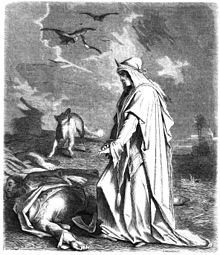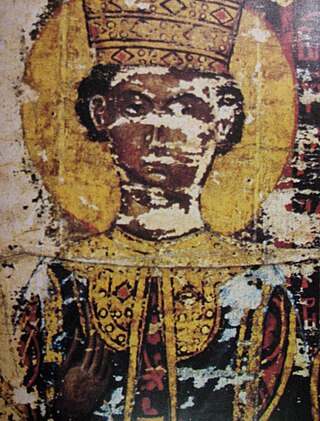
Helena Kantakouzene (died 1463) was the second wife of David of Trebizond, the last Emperor of Trebizond.

Helena Kantakouzene (died 1463) was the second wife of David of Trebizond, the last Emperor of Trebizond.
Donald Nicol has argued that Helena was the sister of George Palaiologos Kantakouzenos, and thus the granddaughter of Matthew Kantakouzenos and possibly the daughter of Theodore Kantakouzenos. [1] Theodore Spandounes reports that George visited her in Trebizond after 1437. [2]
It is unclear which of David's children were also hers; his five children—three boys and two daughters—have been attributed variously to Helena or David's first wife Maria of Gothia by various genealogies. Nevertheless, the oldest sons died with their father 1 November 1463; the youngest son, George, who was three years old, and the daughter Anna were spared. Spandounes states they were sent as a present to Sultan Uzun Hassan of the Aq Qoyunlu, where George was converted to Islam, but he eventually escaped and abjured to Christianity. [3] Spandounes says the name of the king who sheltered George Kantakouzene and gave him his daughter in marriage was named "Gurguiabei", which has been interpreted as a king of Georgia (and either George VIII or Constantine II), or "Guria Bey", ruler of Guria. [4] Anna's fate is less clear. The historian Laonikos Chalkokondyles contradicts Spandounes, writing that after being "summoned to his bedchamber", Anna was married to Zagan Pasha; however, when he learned Zagan attempted to force her to become a Muslim, Mehmet separated them. [5] A local tradition connects Anna to a village south of Trabizon called "Lady Village", where in 1870 an inscription bearing Anna's name was seen in the village church dedicated to the Archangels. [6]
On 15 August 1461, Mehmed II of the Ottoman Empire forced Emperor David to surrender his throne in return for a pension. David and his family were settled on estates near Serres in the Struma valley, comprising an annual income of some 300,000 pieces of silver. Although Helena presumably was with him, Donald Nicol mentions a source which states David had sent her to refuge with the Georgian prince Mamia of Guria prior to Mehmed's arrival before the walls of Trebizond. [7] After two years, his former retainer George Amiroutzes accused David of conspiring against Mehmed, and the former emperor was executed with all but one of his sons. [8]
According to Spandounes, Helena survived her husband and sons. The Sultan reportedly had ordered their corpses to be left exposed outside the Walls of Constantinople. When she dug the graves with her own hands and buried them, she was condemned to pay a fine of 15,000 ducats or be executed herself. Her retainers raised the money, but Helena dressed in sackcloth and lived out her days in a straw hut near the corpses of her dead family. [8]
The historian Thierry Ganchou advanced the theory that Helena had not actually existed, being instead the result of the confusion between David's mother Theodora Kantakouzene and his wife Maria of Gothia by the historian Theodore Spandounes. Ganchou refers to the historical writings of Angelo Massarelli, the Papal Secretary to the Council of Trent, [9] [a] which state that Theodora was the daughter of Theodore Kantakouzenos. This identification is also reinforced by the historian George Sphrantzes, who refers to Theodora's other son John IV as a cousin to Mara Branković, herself a granddaughter of Theodore. However, as Theodore is also commonly identified as the father of Helena, this would result in the extremely unlikely scenario where Helena had married her own nephew. In addition to this, given that Theodore had died in 1410, Helena would have been at least fifty years old at the birth of her youngest child. This birth year would also have required that David's first wife Maria, whom he had married either in 1426 or 1429, die very quickly afterwards in order for Helena to have still been young enough to be available for marriage. [10]
Given that the only contemporary source which mentions Helena is Spandounes, Ganchou posits that these discrepancies can be explained by the fact that Spandounes had unintentionally invented her. Ganchou believes that Spandounes (who was a descendant of the Kantakouzenos) was aware that a member of the house had married an emperor of Trebizond, but that he had not known her name, nor that of the emperor. [b] It may be that he had assumed that the emperor in question was the final ruler of the kingdom and then, given that the name Helena appears frequently among the Kantakouzenos, assigned it to the unnamed wife. This was something that the historian had done elsewhere in his works, when he mistakenly also referred to Irene of Serbia, another daughter of Theodore, as Helena. Ganchou then concludes that since there is no known death date for Maria of Gothia, it may have been her who had outlived David and performed the famous burial. [10]
David Megas Komnenos was the last Emperor of Trebizond from 1460 to 1461. He was the third son of Emperor Alexios IV of Trebizond and Theodora Kantakouzene. Following the fall of Trebizond to the Ottoman Empire, he was taken captive with his family to the Ottoman capital, Constantinople, where he and his sons and nephew were executed in 1463.
The House of Kantakouzenos, also found in English-language literature as Cantacuzenus or Cantacuzene, was a Byzantine Greek noble family that rose to prominence in the middle and late Byzantine Empire. The family became one of the empire's wealthiest landowners and provided several prominent governors and generals, as well as two Byzantine emperors between 1347–1357.

Lazar Branković was Despot of Serbia, from 1456 to 1458. He was the third son of Despot Đurađ Branković and his wife, Eirene Kantakouzene. He died without sons, and was succeeded by his elder brother, Despot Stefan Branković.

Matthew Asen Kantakouzenos or Cantacuzenus was Byzantine Emperor from 1353 to 1357 and later Despot of the Morea from 1380 to 1381.

Alexios III Megas Komnenos, or Alexius III, was Emperor of Trebizond from December 1349 until his death. He is perhaps the best-documented ruler of that country, and his reign is distinguished by a number of religious grants and literary creations.

Irene Kantakouzene, known simply as Despotess Jerina, was the wife of Serbian Despot Đurađ Branković. In Serbian folk legends, she is the founder of many fortresses in Serbia.

John IV Megas Komnenos was Emperor of Trebizond from 1429 until his death. He was a son of Emperor Alexios IV of Trebizond and Theodora Kantakouzene.
Irene Asanina, was the empress consort of John VI Kantakouzenos of the Byzantine Empire. She is known to have participated in military issues in a degree uncommon for a Byzantine empress. She commanded the garrison of Didymoteicho during the Byzantine civil war of 1341–1347, and organized the defense of Constantinople against the Genoese in 1348, and the forces of John V in 1353.
Helena Kantakouzene was the Empress consort of John V Palaiologos of the Byzantine Empire. She served as Regent during the absence of her son Manuel II in 1393.
Irene Palaiologina was the empress consort of Matthew Kantakouzenos.

Theodora Komnene Kantakouzene was Empress of the Empire of Trebizond as the consort of Emperor Alexios III Megas Komnenos from their marriage in 1351 until her retirement after her husband's death in 1390.
Theodora Kantakouzene Megale Komnene was the Empress consort of Alexios IV of Trebizond. Said to be very beautiful, according to the chronicle of Laonikos Chalkokondyles, she was accused by her son, John Megas Komnenos, of having an affair with the protovestiarios of the court of Trebizond; however, other accounts describe her as a faithful and loving wife, who kept the peace between Alexios and his sons. In either case, during her lifetime their son John fled to Georgia and did not return until after Theodora's death.
Maria of Gothia was the first wife of David of Trebizond, last Emperor of Trebizond, whom she married in 1426.
Eudokia Megale Komnene, was a Trapezuntine princess and a member of the powerful Byzantine Komnenos dynasty as a daughter of Emperor Alexios III of Trebizond.
Andronikos Palaiologos Kantakouzenos was the last Grand Domestic of the Byzantine Empire. Present in the city at the Fall of Constantinople in 1453, he was one of the group of high Imperial officials executed by Ottoman Sultan Mehmet II five days after the city was taken.
Thomas Kantakouzenos was a Byzantine aristocrat, a member of the Kantakouzenos family, who became a Serbian magnate and general that served Despot Đurađ Branković. He was the brother of Irene Kantakouzene, Đurađ's wife.
George Palaiologos Kantakouzenos was a Byzantine aristocrat, a member of the Kantakouzenos family, and adventurer. He is also known by the Turkish nickname Sachatai, which he earned in the service of the Despot Constantine early in his military career.
Helena Asanina Kantakouzene was regent of the Lordship of Salona in Frankish Greece from 1382 until its conquest by the Ottoman Empire in 1394 on behalf of her daughter Maria Fadrique.
Theodore Spandounes was an early 16th-century Greek historian of noble Byzantine extraction; the son of exiles fleeing the Ottoman conquest of Byzantium who had settled in Venice, Italy. As a youth he stayed with relatives in Ottoman-ruled Macedonia and visited the Ottoman capital at Constantinople, acquiring a knowledge of their history and culture. In later life he served successive Popes as a counsellor and repeatedly advocated the dispatch of a new Crusade against the Ottomans. His chief legacy is his Italian-language history on the origins of the Ottoman state and its history up to that time, whose first version was published in 1509 in Italian and was soon translated into French. Spandounes continued working on it, with the final version appearing in 1538. The work is disorganized and contains errors, but is extremely valuable as a historical source for its wealth of information.
Theodore Palaiologos Kantakouzenos was a Byzantine nobleman and probable close relation to the Emperor John VI Kantakouzenos.